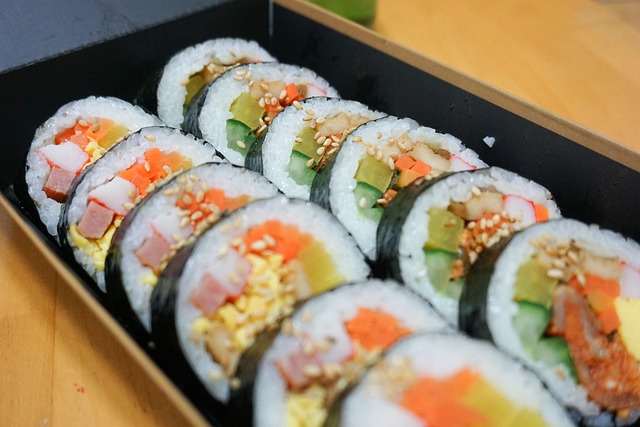
In recent years, Korean cuisine has been making significant waves across the culinary landscape of America, and one dish that has captured the hearts and palates of many is Korean kimbap. This delightful and versatile dish offers a perfect blend of flavors and textures, making it a favorite choice for food enthusiasts seeking a taste of Korea.
Kimbap, which translates to “seaweed rice roll,” originated in Korea and has evolved over time to suit diverse palates and dietary preferences. Traditionally, it consists of seasoned rice and various ingredients such as vegetables, meat, and pickled radish, all neatly wrapped in seaweed and sliced into bite-sized pieces.
In recent years, Korean kimbap has gained significant popularity in America, thanks to its delicious taste, convenience, and health benefits. It has become a go-to option for those seeking a quick and satisfying meal on the go or as a wholesome snack for any time of the day.
One of the reasons for kimbap’s popularity is its versatility. It can be customized to suit individual tastes and dietary restrictions, with endless possibilities for ingredient combinations. Vegetarian and vegan versions are particularly popular, featuring ingredients like tofu, avocado, and assorted vegetables.
Kimbap’s rise in popularity can also be attributed to its accessibility. Many Korean restaurants and food trucks across America offer kimbap on their menus, making it easy for people to sample and enjoy this flavorful dish. Additionally, pre-packaged kimbap is readily available in grocery stores and convenience stores, catering to busy lifestyles and on-the-go snacking.
The growing popularity of Korean kimbap in America reflects a broader trend of cultural exchange and appreciation. As people become more adventurous in their culinary explorations, they are drawn to the diverse and vibrant flavors of Korean cuisine, including kimbap, which offers a delicious introduction to Korean flavors and traditions.
Korean kimbap’s rise in popularity in America is a testament to its delicious taste, versatility, and cultural appeal. Whether enjoyed as a quick meal, a wholesome snack, or a flavorful introduction to Korean cuisine, kimbap continues to captivate the hearts and taste buds of food enthusiasts across America, enriching the culinary landscape with its delightful flavors and textures.
In the United States, kimbap has become popular for several reasons. Firstly, its delicious and diverse combinations make it appealing to a wide range of tastes. With options like meat, seafood, vegetables, and eggs, people can enjoy customized kimbap that suits their preferences.
Additionally, kimbap is considered a healthy option, as it is often made with fresh ingredients like vegetables and lean proteins. This makes it a popular choice for health-conscious individuals looking for a nutritious meal or snack.
Moreover, kimbap’s convenience and portability contribute to its popularity. It is easy to handle and can be eaten on the go, making it a convenient option for busy lifestyles. Whether enjoyed as a quick meal or a snack, kimbap offers a satisfying and flavorful eating experience.
Lastly, the growing interest in Korean culture in the United States has also contributed to the popularity of kimbap. As Korean entertainment, music, and cuisine gain more exposure, people are increasingly drawn to Korean dishes like kimbap, seeking to explore and experience different aspects of Korean culture.
How to Make Korean Kimbap: A Step-by-Step Guide
Ingredients:
- 5 sheets of seaweed (gim/nori)
- 3 cups cooked short-grain rice
- 1 tablespoon rice vinegar
- 1 tablespoon sugar
- 1 teaspoon salt
- 5 strips of ham or cooked fish cake
- 5 strips of yellow pickled radish (danmuji)
- 1 cucumber, julienned
- 3 eggs, beaten and cooked into thin omelets
- 5 strips of imitation crab meat
- Sesame oil (optional)
- Soy sauce (optional)
Instructions:
- Prepare Rice:
- In a bowl, mix cooked rice with rice vinegar, sugar, and salt. Set aside to cool.
- Prepare Ingredients:
- Cut ham or fish cake, yellow pickled radish, cucumber, and omelets into thin strips.
- Assemble Kimbap:
- Place a sheet of seaweed on a bamboo sushi mat.
- Spread a thin layer of seasoned rice evenly over the seaweed, leaving a small border at the top edge.
- Arrange strips of ham or fish cake, yellow pickled radish, cucumber, omelet, and imitation crab meat in a line along the center of the rice.
- Roll Kimbap:
- Lift the edge of the bamboo mat closest to you and tightly roll it over the ingredients, pressing gently to shape the kimbap.
- Continue rolling until the entire sheet of seaweed is wrapped around the filling.
- Seal the edge by moistening it with a bit of water.
- Slice Kimbap:
- Using a sharp knife, carefully slice the rolled kimbap into bite-sized pieces, about 1 inch thick.
- Serve:
- Arrange the sliced kimbap on a plate and serve with sesame oil and soy sauce for dipping, if desired.
- Enjoy:
- Enjoy your homemade Korean kimbap as a delicious snack or light meal!
This recipe yields tasty and satisfying kimbap, perfect for sharing with family and friends or enjoying on the go.